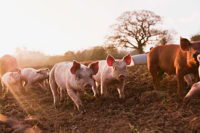Changes to animal welfare policy in the last year by giants such as Starbucks, Aramark and — most recently — Walmart reflect the fact that farm animal welfare is a growing issue of importance in this country as consumers seek food choices that reflect their values.
Survey data backs up this sentiment. In a 2014 survey of 300 shoppers by BFG Communications (http://bit.ly/farmtoplate0815), 76 percent said their concern about the foods they eat had increased from three years ago. And 90 percent of respondents to American Humane Association’s most recent Humane Heartland Farm Animal Welfare Survey said they were “extremely” interested in supporting the humane treatment of farm animals, up five points from the previous year.
But while the general public is moving in the right direction in asking for humanely raised foods, they don’t necessarily know what acceptable animal husbandry practices look like. Some may have never stepped foot on a working farm in their entire lives.
According to the American Farm Bureau Federation, farm and ranch families only account for about 2 percent of the U.S population. Put another way, there are hundreds of millions of Americans who want to support animal welfare, but have little or no experience with the modern agriculture system that produces safe, abundant and affordable meat, eggs and dairy.
That is why we have advocated working with farmers, scientists, ethicists and others to develop and institute indisputable humane standards based on facts, science and experience. Ten years ago, we developed the nation’s first independent, third-party farm animal welfare program, rooted in the internationally accepted Five Freedoms. Based on 200 science-based, species-specific standards, it covers everything from adequate space to temperature, food, water, lighting and air quality.
It’s important to elevate the humane treatment of animals on all sizes of farms — including the large modern intensive farms that raise animals mainly indoors to improve biosecurity and protect humans and animals. Some of these systems look very different than the “Old MacDonald’s” farm people saw in picture books growing up, but can be operated humanely and take into account all the needs of the animals during their lifetime.
The need for a science-based approach to animal welfare couldn’t be clearer than it is in the use of antibiotics in agriculture. Even though science tell us that antibiotics can help improve well-being, decrease mortality rates and prevent unnecessary suffering in farm animals, some activists are pushing for an outright ban on their use in agriculture. We should certainly have a debate about what constitutes judicious use, but jumping to an outright ban defies science (and common sense), will cause more animal suffering, and may even adversely affect public health.
Our survey results show that animal welfare does not need to be a contentious topic — almost everyone agrees that the animals that feed our world should be well treated. An animal welfare system that puts facts above feelings is necessary to protect animals from fads and misinformation campaigns that sometimes put scoring political points above doing what’s right by the animals. Giving producers the benefits of the latest global research, technological advances, best practices and new methods for more humane care will ensure that animals’ lives are actually better based on real science and experience. Animal welfare should not a matter of opinion, but one of quantifiable and demonstrable facts. NP






Report Abusive Comment